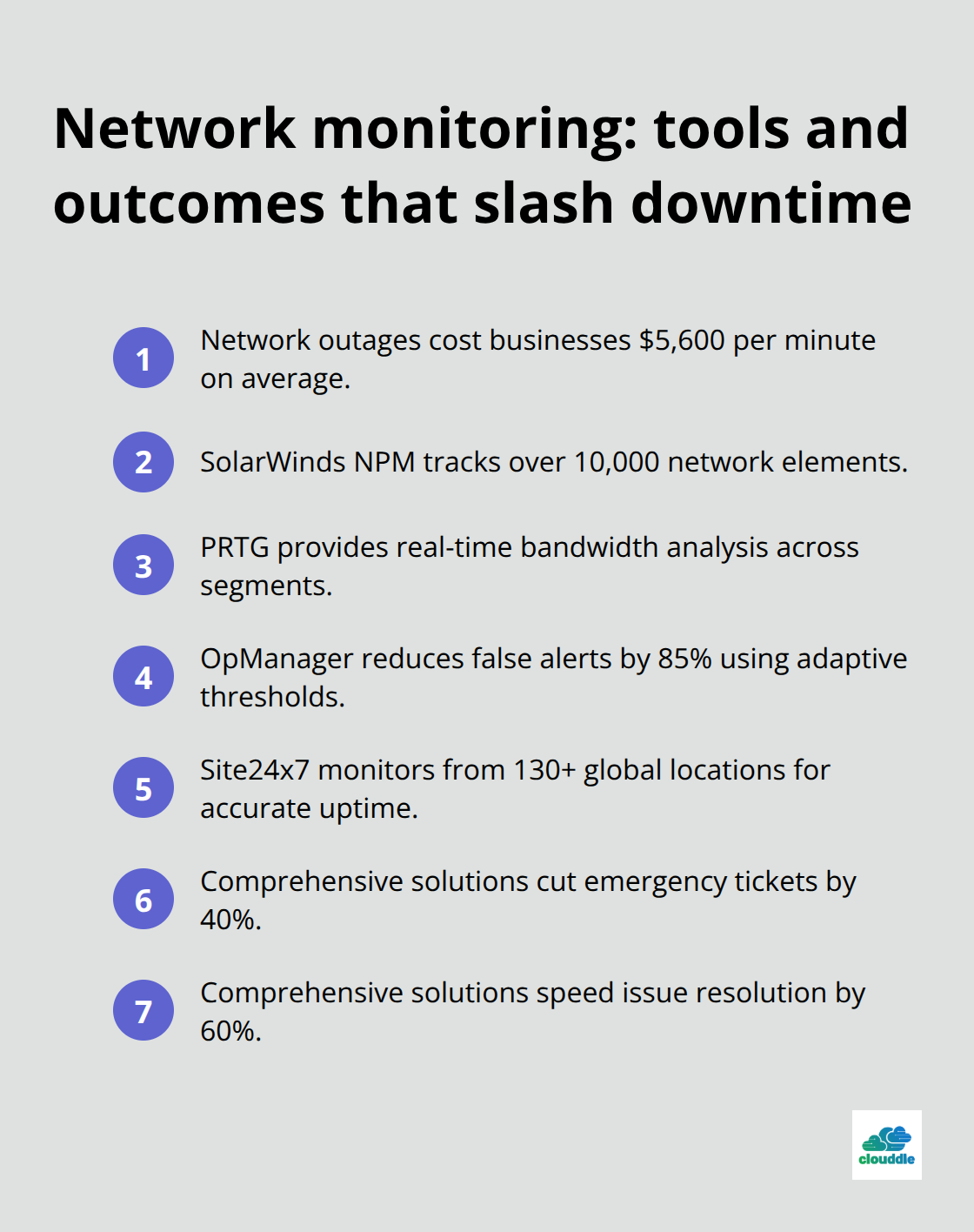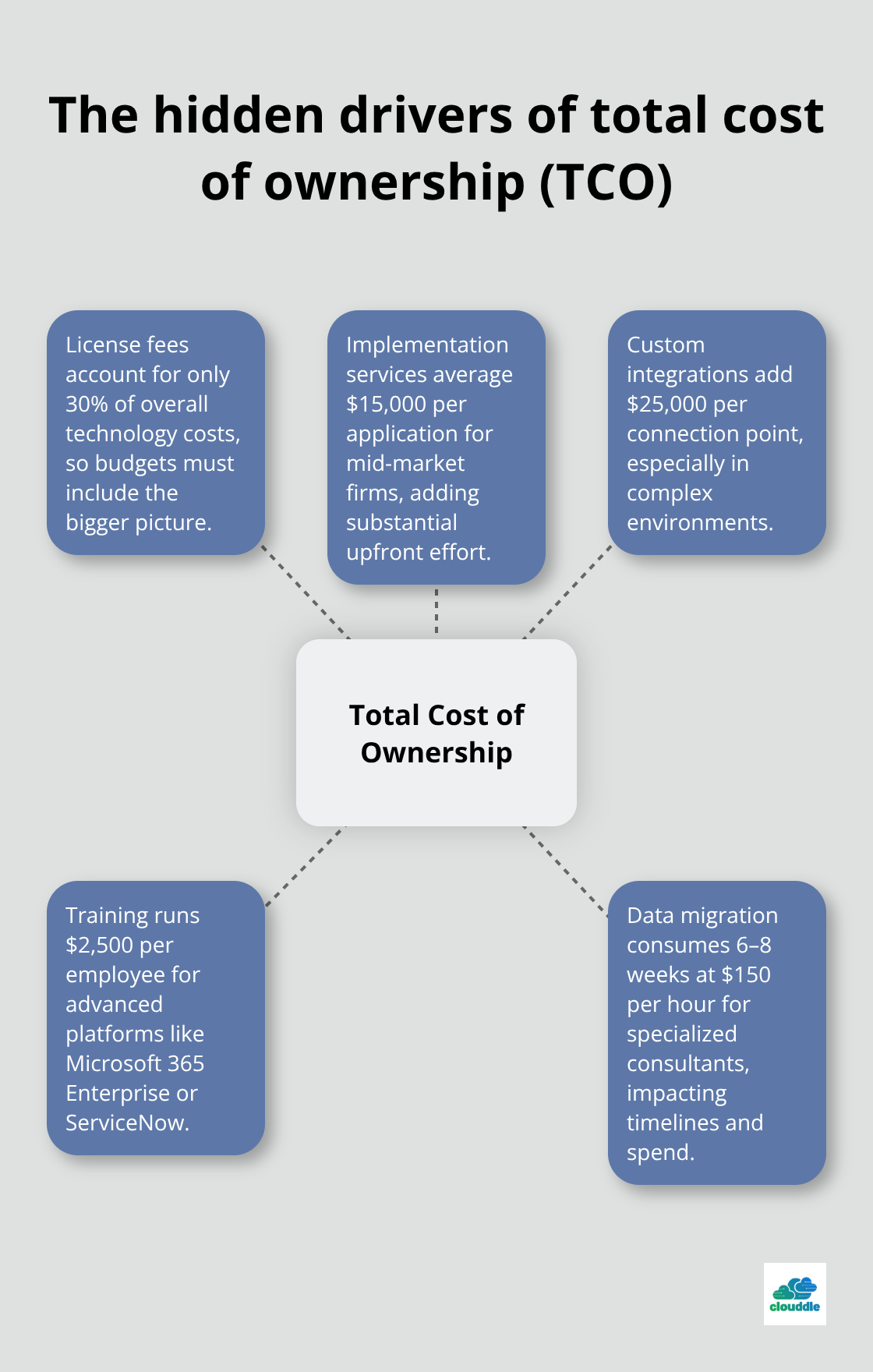Selecting the right technology solutions for managed IT services can make or break your business operations. Poor choices lead to security vulnerabilities, downtime, and wasted resources.
We at Clouddle have seen companies struggle with mismatched IT solutions that drain budgets without delivering results. The key lies in understanding your specific needs before committing to any platform or service.
What Makes Technology Selection Critical
Most businesses approach technology selection backwards. They focus on features and pricing without understanding their actual operational requirements. This approach leads to expensive mistakes, with worldwide IT spending expected to total $5 trillion in 2024 according to Gartner research.
Start with Infrastructure Assessment
Conduct a comprehensive audit of your current systems, network capacity, and daily workflows. Document peak usage times, identify bottlenecks, and map out integration points between existing applications. Companies that conduct thorough infrastructure assessments before they select new solutions reduce implementation failures by 67% (based on McKinsey studies).
Security Standards Drive Everything
Security requirements should dictate your technology choices, not accommodate them afterward. GDPR violations alone cost businesses an average of €28 million per incident according to European Data Protection Board findings. Evaluate every solution against specific compliance frameworks relevant to your industry – HIPAA for healthcare, SOX for financial services, or CMMC for defense contractors.

Look for solutions with built-in encryption, multi-factor authentication, and automated patch management. Zero Trust Network approaches are gaining traction, with 69% of businesses wanting to adopt Security Service Edge platforms within 24 months according to Cybersecurity Insiders research.
Growth Planning Prevents Future Problems
Technology decisions made today will impact your business for 5-7 years minimum. Companies that fail to plan for 300% growth capacity face costly migrations within two years of implementation. Cloud-based solutions offer the most flexibility, with SaaS platforms allowing rapid scaling without hardware investments. However, bandwidth requirements grow exponentially – plan for 10x current usage to avoid performance issues. Businesses using scalable cloud infrastructure report 43% faster time-to-market for new services compared to traditional on-premise solutions according to Deloitte analysis.
These foundational considerations set the stage for evaluating specific technology categories that form the backbone of modern managed IT services.
Which Technology Solutions Actually Work
Cloud platforms dominate the managed IT landscape because they deliver measurable results. Microsoft Azure holds 23% market share while Amazon Web Services commands 32%. However, market share means nothing if the platform doesn’t fit your workload patterns.
Manufacturing companies with legacy systems perform better on hybrid solutions like VMware vSphere, which supports both on-premise and cloud deployments. Financial services firms that require sub-millisecond latency choose bare-metal cloud instances from providers like IBM Cloud or Oracle Cloud Infrastructure. SaaS adoption rates hit 73% for businesses with 100+ employees (based on Flexera’s 2024 State of the Cloud Report), which proves that cloud services deliver faster deployment than traditional models.
Network Monitoring Tools That Prevent Downtime
Network outages cost businesses $5,600 per minute according to Gartner research, which makes proactive monitoring non-negotiable. SolarWinds NPM tracks over 10,000 network elements simultaneously and identifies performance degradation before users notice problems. PRTG Network Monitor excels at bandwidth analysis with real-time graphs that show traffic patterns across all network segments.
ManageEngine OpManager uses AI-driven thresholds that adapt to normal usage patterns and reduces false alerts by 85% compared to static rules. Site24x7 monitors websites, servers, and applications from 130+ global locations and provides accurate uptime measurements for customer-facing services.

Companies that use comprehensive network solutions report 40% fewer emergency support tickets and 60% faster issue resolution times based on Aberdeen Group studies.
Security Solutions That Actually Stop Threats
Endpoint detection and response tools catch 99.7% of malware that traditional antivirus misses according to MITRE ATT&CK evaluations. CrowdStrike Falcon prevents ransomware through behavioral analysis while SentinelOne blocks zero-day exploits with machine learning algorithms. Backup solutions require 3-2-1 strategies with three copies of data, two different media types, and one offsite location.
Veeam Backup leads enterprise deployments with instant recovery capabilities, while Acronis Cyber Backup provides comprehensive protection for small businesses. Immutable backups stored on platforms like AWS S3 Glacier prevent ransomware encryption, with recovery times under four hours for critical systems. Companies that implement modern backup strategies recover from cyberattacks 70% faster than those that use traditional tape-based systems (according to Ponemon Institute research).
These proven technology categories form the foundation for any managed IT strategy, but understanding their true costs requires deeper financial analysis beyond initial purchase prices.
What Do Managed IT Solutions Really Cost
Technology investments demand brutal honesty about total ownership costs, not just sticker prices. Cloud migrations that appear affordable at $50 per user monthly can balloon to $200 per user when bandwidth overages, storage expansion, and premium support factor into the equation. Forrester research shows that 78% of B2B companies are investing in corresponding platforms, though only 31% fully understand the actual total costs. The real expense comes from integration work, staff training, and system downtime during transitions.
License Fees Hide the Real Numbers
License fees represent only 30% of total technology costs according to Gartner analysis. Professional services for implementation average $15,000 per application for mid-market companies, while custom integrations add another $25,000 per connection point. Staff training costs $2,500 per employee for complex platforms like Microsoft 365 Enterprise or ServiceNow. Data migration projects consume 6-8 weeks of IT staff time at $150 per hour for specialized consultants.

Maintenance Contracts Drain Annual Budgets
Annual maintenance contracts typically cost 20-25% of original software purchase prices, with Oracle and SAP charging up to 35% for premium support levels. These contracts often include mandatory upgrades that require additional hardware investments. Support response times vary dramatically between vendors (some guarantee 4-hour response while others offer only next-business-day service). Companies frequently discover that basic support excludes critical features like phone assistance or priority ticket handling.
ROI Calculations That Actually Matter
Productivity gains from properly implemented managed IT solutions average 23% within 12 months based on McKinsey studies. Help desk automation reduces support ticket resolution time from 4 hours to 45 minutes, saving $180 per incident according to HDI benchmarks. Network monitoring tools prevent outages that cost businesses $9,000 per minute for e-commerce companies and $5,600 per minute for manufacturing operations per Ponemon Institute data.
Security solutions deliver 300% ROI through prevented breach costs, with average data breach expenses reaching $4.88 million according to IBM Security reports. Companies that implement comprehensive backup strategies recover 90% faster from ransomware attacks, avoiding average recovery costs of $1.85 million per incident. Smart procurement strategies focus on three-year total cost of ownership rather than monthly fees.
Final Thoughts
Technology solutions for managed IT require systematic evaluation of infrastructure needs, security requirements, and growth projections. Companies that conduct thorough assessments before implementation reduce failures by 67% while achieving 23% productivity gains within 12 months. Focus on total ownership costs rather than initial prices, as maintenance contracts and hidden expenses often triple actual investment amounts.
Security standards must drive every technology decision, with modern solutions that prevent 99.7% of advanced threats that traditional tools miss. Cloud platforms offer the best scalability options, though hybrid approaches work better for manufacturing and financial services with legacy system dependencies. Network monitoring tools prevent costly downtime (averaging $5,600 per minute) while backup strategies reduce ransomware recovery time by 70%.
Implementation success depends on realistic budgets, comprehensive staff training, and vendor selection based on industry expertise rather than market share. We at Clouddle specialize in managed IT solutions across hospitality, multi-family dwelling, and senior living sectors. Our Network as a Service provides 24/7 support and flexible contracts that eliminate upfront investments while delivering measurable operational improvements.


